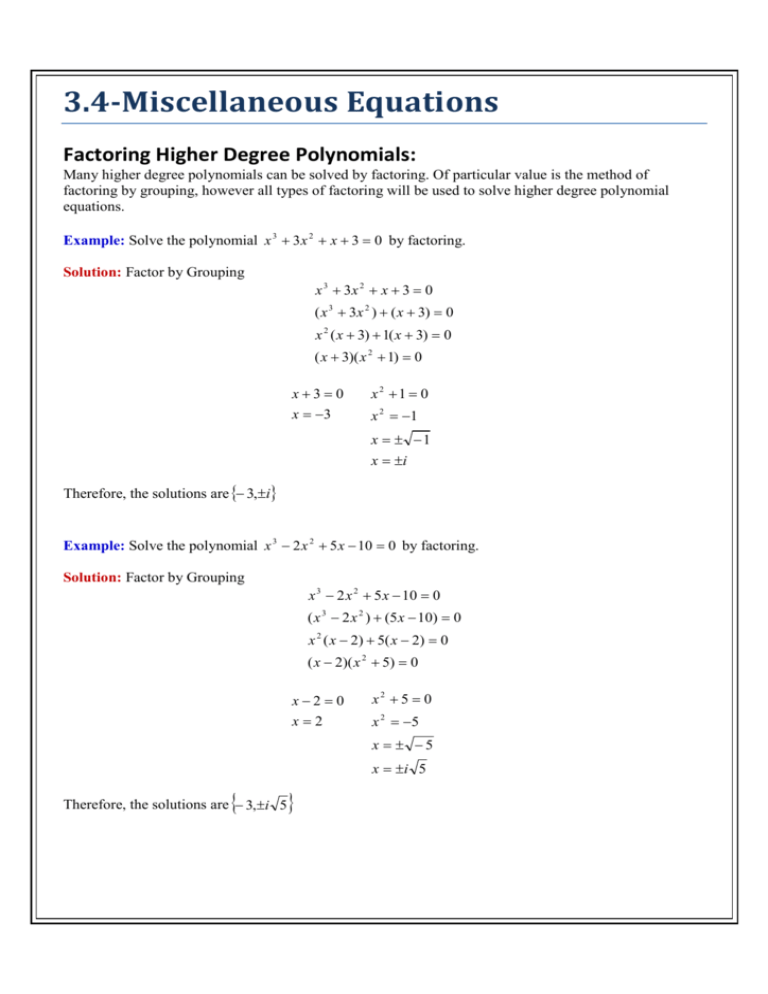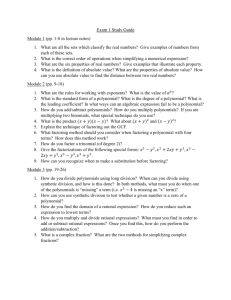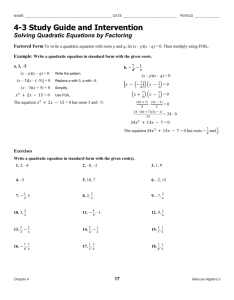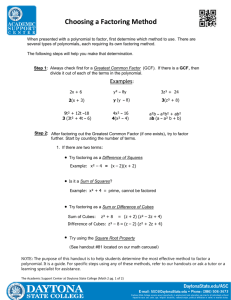3.4 Miscellaneous Equations
advertisement

3.4-Miscellaneous Equations
Factoring Higher Degree Polynomials:
Many higher degree polynomials can be solved by factoring. Of particular value is the method of
factoring by grouping, however all types of factoring will be used to solve higher degree polynomial
equations.
Example: Solve the polynomial x 3 + 3 x 2 + x + 3 = 0 by factoring.
Solution: Factor by Grouping
x 3 + 3x 2 + x + 3 = 0
( x 3 + 3x 2 ) + ( x + 3) = 0
x 2 ( x + 3) + 1( x + 3) = 0
( x + 3)( x 2 + 1) = 0
x+3=0
x = −3
x2 +1 = 0
x 2 = −1
x = ± −1
x = ±i
Therefore, the solutions are {− 3,±i}
Example: Solve the polynomial x 3 − 2 x 2 + 5 x − 10 = 0 by factoring.
Solution: Factor by Grouping
x 3 − 2 x 2 + 5 x − 10 = 0
( x 3 − 2 x 2 ) + (5 x − 10) = 0
x 2 ( x − 2) + 5( x − 2) = 0
( x − 2)( x 2 + 5) = 0
x−2 =0
x=2
x2 + 5 = 0
x 2 = −5
x = ± −5
x = ±i 5
{
Therefore, the solutions are − 3,±i 5
}
Example: Solve the polynomial 2 x 5 = 16 x 2
Solution: Solve by factoring:
2 x 5 = 16 x 2
2 x 5 − 16 x 2 = 0
2 x 2 ( x 3 − 8) = 0
2 x 2 ( x − 2)( x 2 + 2 x + 4) = 0
x−2 =0
2x 2 = 0
x=0
x=2
The factor x 2 + 2 x + 4 is not factorable, use another method such as completing the square.
x 2 + 2x + 4 = 0
x 2 + 2x + 1 = 1 − 4
( x + 1) 2 = −3
( x + 1) 2 = ± − 3
x +1 = ± − 3
x = −1 ± i 3
{
Therefore, the solutions are 0,2,−1 ± i 3
}
Example: Solve the polynomial x 5 = 27x 2
Solution: Solve by factoring:
x 5 = 27 x 2
x 5 − 27 x 2 = 0
x 2 ( x 3 − 27) = 0
x 2 ( x − 3)( x 2 + 3 x + 9) = 0
x−3= 0
x2 = 0
x=3
x=0
The factor x 2 + 3 x + 9 is not factorable, use another method such as completing the square.
x 2 + 3x + 9 = 0
x + 3 = ± 3i 3
2
2
x 2 + 3x + 9 = 9 − 9
4
4
3 3i 3
( x + 3 ) 2 = 9 − 36
x=− ±
2
4
4
2
2
2
3
27
(x + ) = −
− 3 ± 3i 3
2
4
x=
2
( x + 3 ) 2 = ± − 27
2
4
(
− 3 ± 3i 3
Therefore, the solutions are 0,3,
2
)
Equations with Radicals:
When solving an equation containing a radical the primary objective is to isolate the term containing the
radical. Once this is accomplished, raise both sides of the equation to an appropriate power in order to
eliminate the radical. Solve the remaining equation. If the equation still contains a radical, repeat the
process.
Example: Solve the equation
x+2= x
Solution: Isolate the radical and then raise both sides to the reciprocal power.
x +2= x
x = x−2
( x)
2
= (x − 2)
2
x = x 2 − 4x + 4
x 2 − 5x + 4 = 0
( x − 4)( x − 1) = 0
x=4
x =1
Because this is an equation containing a square root, we need to check for extraneous roots. By checking
both solutions in the original equation, we determine that x = 1 is not a solution.
Therefore, the only solution is {4}
Example: Solve the equation
x + 12 = x
Solution: Isolate the radical and then raise both sides to the reciprocal power.
x + 12 = x
x = x − 12
( x)
2
= ( x − 12 )
2
x = x 2 − 24 x + 144
x 2 − 25 x + 144 = 0
( x − 16)( x − 9) = 0
x = 16
x=9
By checking both solutions in the original equation, we determine that x = 9 is not a solution.
Therefore, the only solution is {16}
Example: Solve the equation
2x + 1 − x = 1
Solution: Isolate the radical and then raise both sides to the reciprocal power.
2x + 1 − x = 1
(
2x + 1 = x + 1
) (
2
2x + 1 =
)
x +1
2
2x + 1 = x + 2 x + 1
x=2 x
( x) 2 = (2 x ) 2
x 2 = 4x
x 2 − 4x = 0
x( x − 4) = 0
x=0
x=4
Because this is an equation containing a square root, we need to check for extraneous roots. By checking
both solutions in the original equation, we determine that both answers check.
Therefore, the solutions are {0,4}
Example: Solve the equation
3x − 2 − x = 2
Solution: Isolate the radical and then raise both sides to the reciprocal power.
3x − 2 − x = 2
(
3x − 2 = x + 2
3x − 2
) =(
2
x +2
)
2
3x − 2 = x + 4 x + 4
2x − 6 = 4 x
x−3= 2 x
( x − 3) 2 = (2 x ) 2
x 2 − 6x + 9 = 4x
x 2 − 10 x + 9 = 0
( x − 9)( x − 1) = 0
x = 9, x = 1
By checking both solutions in the original equation, we determine that x = 1 is not a solution.
Therefore, the only solution is {9}
Equations with Rational Exponents
If an equation contains a rational exponent, raise both sides of the equation to an appropriate power to
eliminate the exponent. Solve the resulting equation.
Example: Solve the equation x
4
= 625
3
Solution: Raise both sides of the equation to a power which is the reciprocal of the power of x.
x
4
3
= 625
3
x 4 3 4 = (625) 3 4
x = ±125
Example: Solve the equation x
−4
5
= 16
Solution: Raise both sides of the equation to a power which is the reciprocal of the power of x.
x
−4
5
= 16
−5
x − 4 5 4 = (16)− 5 4
1
x=
5
(16) 4
1
x=
32
U-Substitution:
The procedure called u-substitution is a very common and extremely useful mathematical tool. It is used
to create a quadratic equation out of an equation that is not a quadratic equation. When a polynomial is
written in descending order, we generally let the variable of the middle term be equal to another variable,
such as “u”, hence the name u-substitution.
x 4 − 14 x 2 + 45 = 0
Example: Solve the equation
Solution: This equation is not a quadratic equation, but rather a 4th degree equation. We can create a
quadratic equation by doing a “u” substitution. Let u = x 2 , then u 2 = x 4 after squaring both sides.
Substitute these values of u into the equation and solve by any acceptable method. In this case, I used
factoring.
x 4 − 14 x 2 + 45 = 0
u 2 − 14u + 45 = 0
(u − 5)(u − 9) = 0
u=5
u=9
Because our objective is to solve for x not u, we must back-substitute, that is, replace all the u-terms with
x-terms.
u=5
u=9
x2 = 5
x2 = 9
x = ±3
x=± 5
The final answer contains four solutions. Check these solutions in the original equation.
2
1
Example: Solve the equation t 3 − 9t 3 + 8 = 0
Solution: This equation is not a quadratic equation, but rather an equation with rational exponents which
is really a radical equation. We can create a quadratic equation by doing a “u” substitution.
1
2
Let u = t 3 , then u 2 = t 3 after squaring both sides. Substitute these values of u into the equation and solve
by any acceptable method. In this case I used factoring.
2
3
1
3
t − 9t + 8 = 0
u 2 − 9u + 8 = 0
(u − 8)(u − 1) = 0
u =8
u =1
Because our objective is to solve for t not u, we must back-substitute, that is, replace all the u-terms with
t-terms.
u =8
u =1
1
3
1
3
t =8
t =1
3
3
13
t = (8)3
t = 512
13
t = (1)3
t =1
The final answer contains two solutions. Check these solutions in the original equation.
Example: Solve the equation x − 4 x + 4 = 0
Solution: This equation is not a quadratic equation, but rather a radical equation. We can create a
quadratic equation by doing a “u” substitution.
Let u = x , then u 2 = x after squaring both sides. Substitute these values of u into the equation and solve
by any acceptable method. In this case, I used the square root property.
x−4 x +4=0
u 2 − 4u + 4 = 0
(u − 2) 2 = 0
u−2=0
u=2
Because our objective is to solve for x not u, we must back-substitute, that is, replace all the u-terms with
x-terms.
u=2
x =2
( x)
2
= 22
x=4
The final answer has one solution. Check this solution in the original equation.
Equations with Absolute Value:
Absolute value is the distance from zero on the number line. However, to solve equations containing
absolute value expressions we use the more formal definition of absolute value. This definition will
provide us with a procedure for solving absolute value equations.
x, if .x > 0
x =
− x, if .x < 0
This definition states that x = x , if x > 0 and x = − x , if x < 0. It is important to interpret –x as the
opposite of x and not negative x.
Example: Solve the equation
x 2 − 2 x − 16 = 8
Solution: Solve by using the definition of absolute value as discussed in a previous set of notes.
x 2 − 2 x − 16 = 8
x 2 − 2 x − 16 = −8
x 2 − 2 x − 24 = 0
x 2 − 2x − 8 = 0
( x − 6)( x + 4) = 0
( x − 4)( x + 2) = 0
x=6
x=4
x = −4
x = −2
The solution is therefore {− 4,−2,4,6}
Example: Solve the equation
x2 − x − 4 = 2
Solution: Solve by using the definition of absolute value as discussed in a previous set of notes.
x2 − x − 4 = 2
x 2 − x − 4 = −2
x2 − x − 6 = 0
x2 − x − 2 = 0
( x − 3)( x + 2) = 0
( x − 2)( x + 1) = 0
x=3
x=2
x = −2
x = −1
The solution is therefore {− 2,−1,2,3}
3.4-Applications
Example: One leg of a right triangle is 1 cm longer than the other leg. What is the length of the short leg
if the total length of the hypotenuse and the short leg is 10 cm?
Solution: Let x = the length of the short leg. Then x + 1 is the length of the other leg. The hypotenuse will
be defined as
( x ) 2 + ( x + 1) 2 .
If the hypotenuse plus the short leg are equal to 10 we will have the following equation to solve.
10 = x + ( x) 2 + ( x + 1) 2
10 − x = ( x) 2 + ( x + 1) 2
(10 − x) 2 = 2 x 2 + 2 x + 1
100 − 20 x + x 2 = 2 x 2 + 2 x + 1
x 2 + 22 x − 99 = 0
Since we now have a quadratic, use any appropriate method.
− 22 ± 484 + 396
2
− 22 ± 29.66
x=
2
x = −25.83, x = 3.83
x=
The only answer that makes sense in the context of the problem is 3.83 which also checks. Therefore the
shortest side of the triangle is 3.83.
Example: The minimum displacement D for a yacht with length 21.52 m and a sail area of 310.64 m 2 is
determined by the equation
L + 1.25S 2 − 9.8D 3 = 16.296
1
Find the boats minimum displacement.
Solution: Solve the equation for D.
L + 1.25S 2 − 9.8D 3 = 16.296
1
1
21.52 + 1.25(310.64) 2 − 9.8D 3 = 16.296
1
1
21.52 + 22.03 − 9.8D 3 = 16.296
1
9.8D 3 = 27.254
1
D 3 = 2.78
1
D = (2.78)
D = 21.48
3
The minimum displacement is 21.48
1
Example: If the width of the base of a cubic container is increased by 3 m and the length of the base
decreased by 1 m, then the volume of the new container is 6 m 3 . What is the height of the cubic
container?
Solution: Let x equal the dimensions of the original cubic container. The new width is equal to x+3 and
the new length is x-1. The height will be x. This gives us the following equation based on the formula for
the volume of a cubic container V ( x ) = l × w × h .
V = x( x + 3)( x − 1)
6 = x ( x 2 + 2 x − 3)
x 3 + 2 x 2 − 3x − 6 = 0
Since this is a 3rd degree polynomial, try factoring by grouping.
x 3 + 2 x 2 − 3x − 6 = 0
( x 3 + 2 x 2 ) − (3 x + 6) = 0
x 2 ( x + 2) − 3( x + 2) = 0
( x 2 − 3)( x + 2) = 0
Use the zero product property to obtain
x2 − 3 = 0
x+2=0
x2 = 3
x = −2
x=± 3
Therefore, the height of the cubic container is 3 .
Example: The capsize screening value C is defined as
d
C = b
64
− 13
Where b is the beam (width) in feet and d is the displacement in pounds. The Bahia 46 is a 46 ft
catamaran with a capsize screening value of 3.91 and a beam of 26.1 ft. Find the displacement of the
Bahia 46.
Solution: Solve the equation for d.
d
C = b
64
C 64
=
b d
1
− 13
3
3
64
C
=
d
b
3
C
d = 64
b
64b 3 64(26.1) 3
d= 3 =
= 19,035.95
C
(3.91) 3
The displacement is 19,035.95.
Example: A tour operator uses the equation C = 3 x + 50 x + 9000 to find his cost in dollars for taking x
people on a tour of San Francisco. For what value of x is the cost $160.00? If he charges $10.00 per
person for the tour, then what is his break-even point?
Solution: Solve this equation for x.
C = 3 x + 50 x + 9000
160 = 3x + 50 x + 9000
160 − 3x = 50 x + 9000
(160 − 3x )2
= 50 x + 9000
25,600 − 960 x + 9 x 2 = 50 x + 9000
9 x 2 − 1010 x + 16,600 = 0
Since we now have a quadratic, use any appropriate method.
− b ± b 2 − 4ac
2a
1010 ± 1020100 − 597600
x=
18
1010 ± 650
x=
18
x = 92.2, x = 20
x=
The number 92.2 does not check in the original equation so the only solution is 20. The revenue function
will be R(x)=10x. To find the break-even point, set the two equations equal and solve.
10 x = 3 x + 50 x + 9000
7 x = 50 x + 9000
49 x 2 = 50 x + 9000
49 x 2 − 50 − 9000 = 0
Since we now have a quadratic, use any appropriate method.
50 ± 2500 + 1764000
98
50 ± 1329.1
x=
98
x = 14, x = −13.05
x=
Since a negative value does not make sense in the context of the problem, the only solution is 14. The
break-even point is 14 people.
Example: Two vertical poles of lengths 6 feet and 8 feet stand 10
feet apart. A cable reaches from the top of one pole to some point
on the ground between the poles and then to the top of the other
pole. Where should this point be located to use exactly 18 feet of
cable?
Solution:
The solution to this problem requires the use of the Pythagorean
Theorem. Because there are two triangles, we will use the
Pythagorean Theorem twice. For each triangle, the length of the cable is equal to the hypotenuse of the
triangle.
For the small triangle, the hypotenuse is: x 2 + 36
For the large triangle the hypotenuse is: (10 − x) 2 + 64
The total length of the cable is the sum of the two hypotenuses. Since we are told that this length must
be 18 feet, we have the equation:
(10 − x ) 2 + 64 + x 2 + 36 = 18
Solve this equation:
(10 − x) 2 + 64 + x 2 + 36 = 18
(10 − x) 2 + 64 = 18 − x 2 + 36
( (10 − x)
2
+ 64
) = (18 −
2
x 2 + 36
)
2
(10 − x ) 2 + 64 = 324 − 36 x 2 + 36 + x 2 + 36
100 − 20 x + x 2 + 64 = 324 − 36 x 2 + 36 + x 2 + 36
196 + 20 x = 36 x 2 + 36
(196 + 20 x )2 = (36
x 2 + 36
)
2
38,416 + 7,840 x + 400 x 2 = 1,296( x 2 + 36)
38,416 + 7,840 x + 400 x 2 = 1,296 x 2 + 46,656
896 x 2 − 7840 x + 8,240 = 0
x ≈ 7.52
x ≈ 1.22
Since both answers check in the original equation, the point should be located approximately 7.52 feet
or 1.22 feet from the base of the 6 foot pole.
Example: William, Nancy and Edgar met at the lodge at 8:00 AM, and William began hiking west at 4
mph. At 10:00 AM., Nancy began hiking north at 5 mph and Edgar went east on a three-wheeler at 12
mph. At what time was the distance between Nancy and Edgar 14 miles greater than the distance
between Nancy and William?
Solution: Setting up this problem will require use of two basic concepts
in mathematics; the Pythagorean Theorem, and the uniform motion
formula D = RT .
It will be helpful to draw a diagram of this scenario. Let x = the time
William begins walking.
Before we can apply the Pythagorean Theorem we need to determine the length (distance) of each leg
of the triangles. To do this we will use the motion formula.
Williams Leg (D) = RT = 4x
Nancy’s Leg (D) = RT = 5(x-2)
Edgars Leg (D) = RT = 12(x-2)
Now we can apply the Pythagorean Theorem with the given distances.
D1 = (4 x) 2 + (5 x − 10) 2
D2 = (12 x − 24) 2 + (5 x − 10) 2
The equation is based on the fact that D1 + 14 = D2
14 + (4 x) 2 + (5 x − 10) 2 = (12 x − 24) 2 + (5 x − 10) 2
14 + 41x 2 − 100 x + 100 = (13x − 26) 2
14 + 41x 2 − 100 x + 100 = 13 x − 26
41x 2 − 100 x + 100 = 13x − 40
( 41x
2
− 100 x + 100
) = (13x − 40)
2
2
128 x 2 − 940 x + 1500 = 0
x = 5, x = 2.34
The value 2.34 does not check in the original equation, therefore the time is 5 hours or 1:00 PM.








